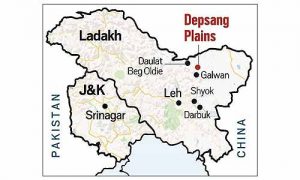Daily Current Affairs for Government Exams:
Today Current Affairs: 10th July 2020 for UPSC IAS exams, State PSC exams, SSC CGL, State SSC, RRB, Railways, Banking Exam & IBPS, etc
Table of Contents
Contents:
- Solar Project set up at Rewa
- Mongolian Kanjur
- Capital Infusion for the Insurance Companies:
- Patrolling points (PPs):
- latest World Drug Report of the United Nations Office on Drugs and Crime (UNODC).
- Ranthambore National Park:
- Malabar Exercise:
- Other important current affairs
1. Solar Project set up at Rewa:

Prime Minister Modi will dedicate to the nation the 750 MW Solar Project set up at Rewa, Madhya Pradesh on July 10, 2020.
- This project comprises of three solar generating units of 250 MW each located on a 500-hectare plot of land situated inside a Solar Park (total area 1500 hectare).
- The Solar Park was developed by the Rewa Ultra Mega Solar Limited (RUMSL), a Joint Venture Company of Madhya Pradesh UrjaVikas Nigam Limited (MPUVN), and Solar Energy Corporation of India (SECI), a Central Public Sector Undertaking.
- This project will reduce carbon emission equivalent to approx. 15 lakh ton of CO2 per year.
- The Rewa Solar Project was the first solar project in the country to break the grid parity barrier.
- The project is also the first renewable energy project to supply to an institutional customer outside the State, i.e. Delhi Metro, which will get 24% of energy from the project with the remaining 76% being supplied to the State DISCOMs of Madhya Pradesh.
- It has also received World Bank Group President’s Award for innovation and excellence.
2.Mongolian Kanjur:

The Ministry of Culture had taken up the project of reprinting of 108 volumes of Mongolian Kanjur under the National Mission for Manuscripts (NMM).
- Now, the first set of five volumes of Mongolian Kanjur has been released.
- In the Mongolian language ‘Kanjur’ means ‘Concise Orders’- the words of Lord Buddha in particular.
- It is held in high esteem by Mongolian Buddhists and they worship the Kanjur at temples and recite the lines of Kanjur in daily life as a sacred ritual.
- The Mongolian Kanjur has been translated from Tibetan. The language of the Kanjur is Classical Mongolian.
- The historical connection between India and Mongolia:
- Historical interaction between India and Mongolia goes back centuries.
- Buddhism was carried to Mongolia by Indian cultural and religious ambassadors during the early Christian era.
- As a result, today, Buddhists form the single largest religious denomination in Mongolia.
- India established formal diplomatic relations with Mongolia in 1955.
National Mission for Manuscripts (NMM):
- NMM was launched in February 2003 by the Government of India, under the Ministry of Tourism and Culture.
- It has the mandate of documenting, conserving and disseminating the knowledge preserved in manuscripts.
- India possesses an estimate of ten million manuscripts, probably the largest collection in the world.
- These cover a variety of themes, textures and aesthetics, scripts, languages, calligraphies, illuminations and illustrations.
3.Capital Infusion for the Insurance Companies:

Recently, the Union Cabinet has approved the capital infusion of Rs.12,450 crore in the three Public Sector General Insurance Companies (PSGICs) namely Oriental Insurance Company Limited (OlCL), National Insurance Company Limited (NICL) and United India Insurance Company Limited (UIICL).
- The primary regulator for insurance in India is the Insurance Regulatory and Development Authority of India (IRDAI).
- The capital infusion of Rs. 3,475 Crore will be allocated to three PSGICs as the first tranche in the current financial year and the balance amount will be released in one or more tranches.
- To give effect to the infusion, the authorized capital of NICL has been increased to Rs. 7,500 Crore and that of UIICL and OlCL to Rs. 5,000 Crore respectively.
Impact: - The capital infusion will enable the three PSGICs to improve their financial and solvency position.
- It will also help to meet the insurance needs of the economy and enhance the capacity to raise resources and improve risk management.
- The government has dropped the process of merger, which was proposed, in the 2018-19 Budget, of these three PSGICs in view of the economic crisis created due to the Covid-19 pandemic.
- Instead, it has decided to focus on the profitable growth of these three PSGICs.
- The aim of the merger was to augment capital by listing the merged entity on stock exchanges, which would have brought down government equity (share).
- The firms were also not in good shape.
- As of the third quarter of 2019-20, NICL had a solvency ratio of 1.01, against the regulatory requirement of 1.5.
- The solvency ratio examines a company’s ability to meet its long-term obligations.
- Its combined ratio stood at 173%. If the ratio is below 100%, it indicates that the firm is making underwriting profits.
- The combined ratio is a measure of profitability used by an insurance company to gauge how well it is performing in its daily operations.
- Underwriting profit consists of the earned premium remaining after losses have been paid and administrative expenses have been deducted.
- OICL had a solvency ratio of 1.54 and reported a combined ratio of 132%.
- UIICL had a solvency ratio of 0.94, much below the regulatory requirement, with a combined ratio of 127.62%.
4. Patrolling points (PPs):

The standoffs between Indian and Chinese troops in Ladakh on the Line of Actual Control (LAC), where initial steps towards disengagement have taken place, are around a number of patrolling points (PPs) in Galwan, Hot Springs and Gogra areas.
- Patrolling Points (PPs) are identified and marked on the Line of Actual Control (LAC), which are patrolled with a stipulated frequency by the security forces.
- They serve as a guide to the location of the LAC for the soldiers, acting as indicators of the extent of ‘actual control’ exercised on the territory by India. By regularly patrolling up to these PPs, the Indian side is able to establish and assert its physical claim about the LAC.
- Not all of the Patrolling Points are numbered. Some of the PPs are prominent and identifiable geographical features, such as a pass, or a Nala junction where no numerals are given.
- Almost all of the Patrolling Points are on the LAC, except for the Depsang plains in northern Ladakh, where PP10, PP11, PP11A, PP12 and PP13 – from Raki Nala to Jivan Nala – do not fall on the LAC. These are short of the LAC, on the Indian side.
- The PPs are not posts and thus not manned. They are just physical markers on the ground, chosen for their location and have no defensive potential or tactical importance for the Army.
- PPs 10 to 13 in the Depsang sector, PP14 in Galwan, PP15 in Hot Spring, and PP17 and PP17A in Gogra are currently being disputed by both sides, where the standoffs have taken place in the past nine weeks.
5.Latest World Drug Report of the United Nations Office on Drugs and Crime (UNODC).

The fourth highest seizure of opium in 2018 was reported from India, after Iran, Afghanistan, and Pakistan, according to the latest World Drug Report of the United Nations Office on Drugs and Crime (UNODC).
- The maximum of 644 tonnes of opium was seized in Iran, followed by 27 tonnes in Afghanistan and 19 tonnes in Pakistan. In India, the figure stood at four tonnes in 2018.
- In terms of heroin seizure (1.3 tonnes), India was at the 12th position in the world. Again, Iran reported the highest seizure of heroin (25 tonnes). Heroin is manufactured from the morphine extracted from the seed pod of opium poppy plants.
- Close to 97% of the total global production of opium in the past five years came from only three countries. Afghanistan accounted for 84% of the global opium production, Myanmar accounted for 7% and Mexico accounted for 6%.
- The global area under opium poppy cultivation declined for the second year in a row in 2019. It went down by 17% in 2018 and by 30% in 2019.
- The opiates seized in the largest quantity in 2018 continued to be opium (704 tonnes), followed by heroin (97 tonnes) and morphine (43 tonnes).
- Quantities of seized opiates remained concentrated in Asia, notably in south-west Asia (70%).
6. Ranthambore National Park:

Ranthambore National Park was established initially as Sawai Madhopur Game Sanctuary in 1955 by the Government of India.
- In 1973, it was declared as a Tiger Reserve under Project Tiger.
- In1980, Ranthambore was declared a national park, while the forests located beside it were named Sawai Man Singh Sanctuary & Keladevi Sanctuary.
- Location: Ranthambore Tiger Reserve lies in the eastern part of Rajasthan state in Karauli and Sawai Madhopur districts, at the junction of the Aravali and Vindhya hill ranges.
- The vegetation includes grasslands on plateaus and dense forests along the seasonal streams.
- The forest type is mainly tropical dry deciduous with ‘dhak’ (Butea monosperma), a species of tree capable of withstanding long periods of drought, being the commonest.
- This tree is also called as ‘Flame of forest’ and is one of the many flowering plants that add colour to the dry summers here.
- Other Common Names: Battle of Plassey tree, Bengal kino, Palash tree, parrot tree, etc.The park is rich in wildlife with tigers at the apex of the food chain in mammals.
- Other animals found here are leopards, striped hyenas, common or Hanuman langurs, rhesus macaques, jackals, jungle cats, caracals, blackbuck, Black-naped hare, and chinkara, etc.
- The park is rich in birds with about 272 species recorded so far.
- This area with tigers in it represents the north-western limit of the Bengal tiger’s distribution range and is an outstanding example of Project Tiger’s efforts for conservation in the country.
7. Malabar Exercise:

India to shortly take a call on Australia’s inclusion in Malabar.
- Australia’s inclusion would be seen as a possible first step towards the militarization of the Quad coalition, something Beijing has opposed in the past.
- Besides, even Japan and the U.S. have been keen on Canberra’s inclusion for some time now and have been pushing India to consider it.
- Once the government takes a decision to include Australia, as per procedure, the other partner nations — Japan and the U.S. have to be informed to secure their consent, after which a formal invitation would be extended to Australia.
Malabar exercise:
- Malabar began as a bilateral naval exercise between India and the U.S. in 1992 and was expanded into a trilateral format with the inclusion of Japan in 2015.
- It has been delayed this year due to the COVID-19 pandemic.
Quad grouping:
- The quadrilateral formation includes Japan, India, United States, and Australia.
- All four nations find a common ground of being the democratic nations and common interests of unhindered maritime trade and security.
- The idea was first mooted by Japanese Prime Minister Shinzo Abe in 2007. However, the idea couldn’t move ahead with Australia pulling out of it.
Other important current affairs:
1.India Global week 2020:
- Prime Minister Modi inaugurated the India Global week 2020, an international event on India’s globalization. Its theme is “Be The Revival: India and a Better New World”
- The three-day virtual conference, being organized in the UK, is being held from 9 to 11 July.
- It is being organized by India Inc. Group – the UK-headquartered media house behind flagship publications ‘India Global Business’ and the recently-launched diaspora news network ‘iGlobal’.
- India Global Week- 2020 will have 5,000 global participants from 30 nations. In all, 250 global speakers will address the virtual conference in 75 sessions.
- It will also feature a special 100th birth anniversary concert in tribute to the sitar maestro Ravi Shankar by three of his most eminent students.
2. Australia has suspended its extradition treaty with Hong Kong in response to a new national security law imposed by China.
- The extradition treaty was in place since 1993.
- Extradition is the formal process of one state surrendering an individual to another state for prosecution or punishment for crimes committed in the requesting country’s jurisdiction.
- It is generally enabled through a bilateral or multilateral treaty.
- The legal basis for extradition with countries with whom India does not have an Extradition treaty is provided by Section 3 (4) of the Indian Extradition Act, 1962.
- Hong Kong was formerly a British colony and was handed over to mainland China in 1997, becoming one of its Special Administrative Regions (SAR).
- It is governed by a mini-constitution called the Basic Law, which affirms the principle of “one country, two systems”.
- The constitutional document is a product of the 1984 Sino-British Joint Declaration, under which China promised to honour Hong Kong’s liberal policies, a system of governance, an independent judiciary, and individual freedoms for a period of 50 years from 1997.
3.China has announced visa restrictions on people from the USA for behaving badly on Tibet-related issues.
- It is considered a retaliatory step by China over the USA’s visa restrictions for a certain group of Chinese officials.
- The moves come as relations between China and the USA deteriorate over trade, technology, the coronavirus pandemic, and the national security law of Hong Kong.
- China insists Tibet has been part of its territory for centuries.
- Also, it has barred foreign journalists from visiting Tibet since 2008, when the region experienced a wave of protests.
- From 1912 until the founding of the People’s Republic of China in 1949, no Chinese government exercised control over what is today China’s Tibet Autonomous Region (TAR).
- Many Tibetans insist they were essentially independent for most of that time and have protested what they regard as China’s rule imposed after the People’s Liberation Army occupied TAR in 1950.
- Since the 1959 Uprising, the central government of China has been steadily tightening its grip on Tibet.
- The 14th Dalai Lama continues to head the Tibetan government-in-exile from McLeod Ganj, a suburb of Dharamsala, India which coordinates political activities for Tibetans in India.
- China has also not responded to USA’s requests to set up a consulate in the regional capital Lhasa.
- The access to the Tibetan region is vital to keep track of human as well as environmental abuses by China.
- Also, the stability of the region is important as it is the source for major rivers of Asia supporting civilisations for the time immemorial.
4. According to the Office of the Registrar General India, the Infant Mortality Rate (IMR) in Madhya Pradesh has surged by a single point over the previous year to 48 in 2018.
- IMR is the number of deaths of children under one year of age per 1000 live births.
- The Office of the Registrar General is under the Ministry of Home Affairs. It issues the Sample Registration System bulletin, which provides estimates of birth rate, death rate and infant mortality rate for states.
- The country’s average IMR stands at 32 per 1,000 live births which includes an average 36 deaths for rural and 23 for urban areas.
- In Madhya Pradesh it is 52 children in rural areas and 36 in urban areas. Madhya Pradesh has the highest IMR (48) in the country.
- The IMR for boys in the State stood at 51, while for girls it was 46 in 2018.
- As many as 26 infants of 1,000 live births in Madhya Pradesh died within the first seven days constituting more than half the infant deaths.
- Uttar Pradesh has the next highest rate of 43 and Kerala has 7, the lowest among the bigger States.
- Causes: Increasing premature deliveries, infections, birth asphyxiation (lack of oxygen in blood) and delay in securing treatment which leads to complicated deliveries.
5. Operation Samudra Setu, which was launched on 05 May 2020 as part of the national effort to repatriate Indian citizens from overseas during the COVID-19 pandemic has culminated after successfully bringing 3,992 Indian citizens back to their homeland by sea.
- Indian Naval Ships Jalashwa (Landing Platform Dock), and Airavat, Shardul, and Magar (Landing Ship Tanks) participated in this operation which lasted over 55 days and involved traversing more than 23,000 kilometers by sea.
- This operation was undertaken by the Indian Navy in close coordination with the Ministry of External Affairs, Home Affairs, health, and various other agencies of the Government of India and State Governments.
- Indian Navy has previously undertaken similar evacuation operations as part of Operation Sukoon in 2006 (Beirut) and Operation Rahat in 2015 (Yemen).




